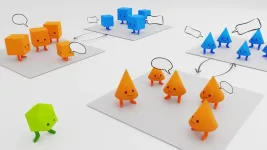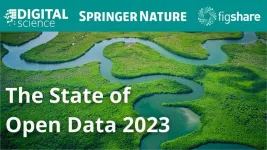(Press-News.org) An existing drug that targets senescent, or sleeping cells could provide the answer to treating lower back pain, according to a new study.
The research, published today as a Reviewed Preprint in eLife, advances our understanding of the role of senescent osteoclasts – cells that break down and remove damaged bone tissue – in the development of lower back pain, which affects 8 in 10 people at some point in their lives. eLife’s editors say the study provides compelling evidence that an existing drug, Navitoclax, can eliminate senescent osteoclasts in mice and, in doing so, markedly reduce spinal pain.
Osteoclasts resorb and break down bone tissue as part of the body’s natural bone remodelling and maintenance process. When these cells become senescent, they no longer function properly, which can lead to problems with bone maintenance and repair.
“It’s previously been shown that senescence promotes age-related musculoskeletal diseases such as osteoporosis, and removing senescent cells from degenerated vertebral discs restores the intervertebral disc structure,” explains lead author Dayu Pan, Postdoctoral Research Fellow in the Departments of Orthopedic Surgery and Biomedical Engineering, Johns Hopkins University School of Medicine, US. “We previously found that osteoclasts cause the endplates between each vertebra and disc to become porous, allowing infiltration of new nerves that cause lower back pain. In this study, we set out to test whether this is caused by a specific group of senescent osteoclasts and whether eliminating these osteoclasts could reduce the pain.”
The research team first set out to identify whether senescent osteoclasts were present in the porous endplates of vertebrae in mice with two types of spine hypersensitivity – one caused by ageing and the other caused by lumbar spine instability. They tested for the simultaneous presence of two markers within the bone – ‘TRAP’ which is a hallmark of osteoclasts, and p16, used to identify senescent cells. In both types of spinal degeneration, they saw a strong association between the presence of senescent osteoclasts and the degree of degeneration and spine hypersensitivity.
Next, they explored whether a drug called Navitoclax, which targets senescent cells, could eliminate senescent osteoclasts and reduce spinal hypersensitivity. As hoped, the treatment caused a significant reduction in senescent osteoclasts compared to untreated mice, as well as reduced pain and increased activity in mice with both types of spine degeneration.
Spinal scans and microscopic examination of bone tissue confirmed there was reduced degeneration and porosity within the endplates, as well as reduced separation between them, in the treated mice. This suggests the anti-senescence drug can prevent the degeneration and remodelling associated with ageing or spine instability.
Finally, because porous endplates allow new nerves to grow into the endplate bone, causing sensitivity, the authors looked at whether senescent osteoclasts play a role in this process. They tested for two markers of nerve fibres in the endplates of mice, as well as markers of new blood vessels, and found that mice treated with the anti-senescence drug had fewer nerves and blood vessels within the endplate than untreated mice. This suggests there is an ongoing dysfunctional production of new bone tissue within the spinal endplate in the ageing or injured spine, and that treatment to remove the senescent osteoclasts could halt this process.
Taken together, these findings suggest a potential role for anti-senescent drugs such as Navitoclax in treating spine pain, but this would need to be further evaluated in clinical trials before the treatment could be used in patients with lower back pain.
“Osteoclasts are the principal bone resorbing cells essential for bone remodelling and skeletal development, but we have shown that osteoclasts in the endplate of the spinal column undergoes senescence, leading to nerve growth and spine pain,” concludes senior author Xu Cao, Professor of Orthopedic Surgery, Department of Orthopedic Surgery and Department of Biomedical Engineering, Johns Hopkins University School of Medicine. “Our findings suggest that depletion of these senescent osteoclasts, perhaps by use of existing drugs, could represent a new strategy in the treatment of lower back pain.”
##
Media contacts
Emily Packer, Media Relations Manager
eLife
e.packer@elifesciences.org
01223 855373
George Litchfield, Marketing and PR Assistant
eLife
g.litchfield@elifesciences.org
About eLife
eLife transforms research communication to create a future where a diverse, global community of scientists and researchers produces open and trusted results for the benefit of all. Independent, not-for-profit and supported by funders, we improve the way science is practised and shared. In support of our goal, we have launched a new publishing model that ends the accept/reject decision after peer review. Instead, papers invited for review will be published as a Reviewed Preprint that contains public peer reviews and an eLife assessment. We also continue to publish research that was accepted after peer review as part of our traditional process. eLife receives financial support and strategic guidance from the Howard Hughes Medical Institute, Knut and Alice Wallenberg Foundation, the Max Planck Society and Wellcome. Learn more at https://elifesciences.org/about.
To read the latest Medicine research published in eLife, visit https://elifesciences.org/subjects/medicine.
END
Drug that kills off sleeping bone cells could treat lower back pain
A study of senescent (inactive) osteoclasts in the vertebral column of mice suggests that using anti-senescent drugs could relieve the spinal sensitivity that causes lower back pain
2023-11-14
ELSE PRESS RELEASES FROM THIS DATE:
Inflammation and loss of protective mechanisms in the brain linked to suicide risk
2023-11-14
GRAND RAPIDS, Mich. (Nov. 14, 2023) — A first-of-its-kind study has identified overactive inflammation and loss of critical protection mechanisms in the brain as potential contributors to suicide risk.
The findings support further exploration of anti-inflammatory medications to reduce risk, especially in situations where suicidal ideation can be ascertained early.
The study was published in the journal Molecular Psychiatry and led by Van Andel Institute’s Lena Brundin, M.D., Ph.D., Columbia ...
Another step toward the HIV-1 vaccine: Dynamics of neutralizing antibodies
2023-11-14
An international team has for the first time researched the longevity of neutralizing antibodies in HIV-1-infected people. Currently, it is assumed that an HIV-1 vaccine can only be effective if it produces these antibodies in vaccinated humans. The findings improve understanding of the dynamics of such antibodies and are an important building block for further research into an HIV-1 vaccine. Professor Dr Florian Klein, Director of the Institute of Virology at the University Hospital Cologne, and Dr Dr Philipp Schommers, Head of the Laboratory for Antiviral Immunity at Department ...
When languages collide, which survives?
2023-11-14
Language has the power to shape our perceptions and interactions with the world. Different languages can coexist, but their dynamics are shaped by the communities that speak them – and how those communities interact with each other. Shared beliefs, assumptions, and feelings toward specific language forms often determine whether a specific language will survive or disappear, especially within multilinguistic societies.
In Chaos, by AIP Publishing, researchers from the University of the Balearic Islands in Spain incorporate language ideologies, along with the impact of interaction between individuals with opposing preferences, on the language shift process.
“Our ...
Keep it secret: Cloud data storage security approach taps quantum physics
2023-11-14
Distributed cloud storage is a hot topic for security researchers around the globe pursuing secure data storage, and a team in China is now merging quantum physics with mature cryptography and storage techniques to achieve a cost-effective cloud storage solution.
Shamir’s secret sharing, a known method, is a key distribution algorithm. It involves distributing private information to a group so that “the secret” can be revealed only when a majority pools their knowledge. It’s common to combine quantum key distribution (QKD) and Shamir’s secret sharing algorithm for secure ...
Putting sound waves to work to create safer public spaces
2023-11-14
WASHINGTON, Nov. 14, 2023 – The risk of hearing loss does not come just from loud machinery or other obvious noise. It can also affect people in public environments like theaters and concert halls. Absorbing this excess sound to make public environments safer for hearing and using the unwanted sound waves to create electricity is the aim of a paper published this week in Physics of Fluids, by AIP Publishing.
“According to the Centers for Disease Control and Prevention, an estimated 12.5% of children and adolescents aged 6-19 years and 17% of adults aged 20-69 years have suffered permanent ...
Severe respiratory disease among children with and without medical complexity during the pandemic
2023-11-14
About The Study: This study of 139,000 respiratory hospitalizations in Canada of children younger than age 18 found a substantial decrease in severe respiratory disease resulting in hospitalizations, intensive care unit admissions, and mortality during the first two years of the pandemic compared with the three pre-pandemic years. These findings suggest that future evaluations of the effect of public health interventions aimed at reducing circulating respiratory pathogens during non-pandemic periods of increased respiratory illness may be warranted.
Authors: Eyal Cohen, M.D., M.Sc., of ...
Type 2 diabetes and colorectal cancer risk
2023-11-14
About The Study: In this study where the majority of 54,000 participants were African American with low socioeconomic status, diabetes was associated with elevated colorectal cancer (CRC) risk, suggesting that diabetes prevention and control may reduce CRC disparities. The association was attenuated for those who completed colonoscopies, highlighting how adverse effects of diabetes-related metabolic dysregulation may be disrupted by preventative screening.
Authors: Shaneda Warren Andersen, Ph.D., of the University of Wisconsin, Madison, is the corresponding author.
To access the embargoed study: Visit our For The Media website at this link https://media.jamanetwork.com/
(doi:10.1001/jamanetworkopen.2023.43333)
Editor’s ...
Von Kaven Award goes to mathematician Lisa Sauermann
2023-11-14
Professor Dr. Lisa Sauermann from Bonn has received this year’s von Kaven Award from the Deutsche Forschungsgemeinschaft (DFG, German Research Foundation) in recognition of her research achievements in the field of extremal combinatorics. The award goes to mathematicians who conduct research under the DFG’s Heisenberg or Emmy Noether Programmes. Endowed with €10,000, this year’s award will be presented on 17 November in connection with the Gauss Lectureship of the German Mathematical Society (Deutsche Mathematiker-Vereinigung, DMV) in Berlin. The laudatory speech will be given by mathematician Professor Dr. Katrin ...
The State of Open Data Report 2023: Support for researchers still lacking
2023-11-14
In the eighth annual The State of Open Data report released today, almost three quarters of surveyed researchers overwhelmingly said they are still not getting the support they need to share their data openly. Such data highlights the increased need for greater community collaboration and tools to support researchers in the move to sustainable open science practices.
For the remaining 23% of respondents who had sought and received support with data sharing, the support primarily came from internal sources (colleague/supervisor – 61%), followed by institutional libraries (31%), research office ...
Land taxation can reduce wealth inequality
2023-11-14
“Of course, opinions on distributional justice differ a lot. However, even if one only slightly dislikes the idea of unequal distribution of wealth, using taxes on land rent is a really good choice for government policy. Taxing land while reducing capital taxes can enhance welfare and at the same time increase economic efficiency and sustainability”, says Ottmar Edenhofer, coauthor and Director of the Potsdam Institute for Climate Impact Research (PIK) as well as of the Mercator Research Institute on Global Commons and Climate Change.
The authors of the study examined how governments can use the “portfolio effect” to reduce wealth ...
LAST 30 PRESS RELEASES:
Heart-brain connection: international study reveals the role of the vagus nerve in keeping the heart young
Researchers identify Rb1 as a predictive biomarker for a new therapeutic strategy in some breast cancers
Survey reveals ethical gaps slowing AI adoption in pediatric surgery
Stimulant ADHD medications work differently than thought
AI overestimates how smart people are, according to HSE economists
HSE researchers create genome-wide map of quadruplexes
Scientists boost cell "powerhouses" to burn more calories
Automatic label checking: The missing step in making reliable medical AI
Low daily alcohol intake linked to 50% heightened mouth cancer risk in India
American Meteorological Society announces Rick Spinrad as 2026 President-Elect
Biomass-based carbon capture spotlighted in newly released global climate webinar recording
Illuminating invisible nano pollutants: advanced bioimaging tracks the full journey of emerging nanoscale contaminants in living systems
How does age affect recovery from spinal cord injury?
Novel AI tool offers prognosis for patients with head and neck cancer
Fathers’ microplastic exposure tied to their children’s metabolic problems
Research validates laboratory model for studying high-grade serous ovarian cancer
SIR 2026 delivers transformative breakthroughs in minimally invasive medicine to improve patient care
Stem Cell Reports most downloaded papers of 2025 highlight the breadth and impact of stem cell research
Oxford-led study estimates NHS spends around 3% of its primary and secondary care budget on the health impacts of heat and cold in England
A researcher’s long quest leads to a smart composite breakthrough
Urban wild bees act as “microbial sensors” of city health.
New study finds where you live affects recovery after a hip fracture
Forecasting the impact of fully automated vehicle adoption on US road traffic injuries
Alcohol-related hospitalizations from 2016 to 2022
Semaglutide and hospitalizations in patients with obesity and established cardiovascular disease
Researchers ‘listen in’ to embryo-mother interactions during implantation using a culture system replicating the womb lining
How changing your diet could help save the world
How to make AI truly scalable and reliable for real-time traffic assignment?
Beyond fragmented markets: A new framework for efficient and stable ride-pooling
Can shape priors make road perception more reliable for autonomous driving?
[Press-News.org] Drug that kills off sleeping bone cells could treat lower back painA study of senescent (inactive) osteoclasts in the vertebral column of mice suggests that using anti-senescent drugs could relieve the spinal sensitivity that causes lower back pain



